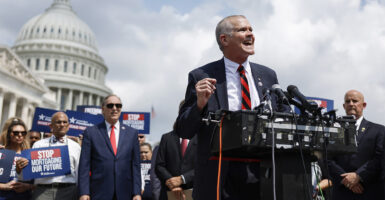The U.S. House of Representatives left Washington July 27 for its lengthy summer recess having only passed one of 12 spending bills required to fund the government for the upcoming fiscal year beginning Oct. 1.
While all 12 bills have welcome reductions, they lack the more substantial cuts necessary to trim the deficit and stop the rampant inflation being caused by excessive government spending.
While funding for the Veterans Administration passed on party lines, House leadership canceled an expected vote on funding for the Department of Agriculture due to a lack of consensus within the GOP caucus. This same dynamic affects the other 10 spending bills as well.
The debate over spending levels will likely be the central legislative battleground for the next few months, and it’s vital for Americans to understand what’s at stake.
There has been an ongoing back-and-forth between House Speaker Kevin McCarthy, R-Calif., and conservatives in the House Freedom Caucus over where to set spending levels for fiscal year 2024. The Freedom Caucus has pushed for a reduction to 2022 levels, which Republicans agreed to in passing the Limit, Save, Grow Act this spring.
Unfortunately, the flawed bipartisan debt limit deal supplanted Limit, Save, Grow, and in the process, set up tens of billions of dollars in budget gimmicks.
This meant that not only would there not be the type of spending cuts needed to help fight inflationary deficit spending, but there could very well be a spending increase when all is said and done.
The House Appropriations Committee has now produced initial versions of all 12 of the annual spending bills. In response, members of the Freedom Caucus have demanded lower spending levels through a combination of dumping fraudulent gimmicks and imposing stronger spending cuts on the swampy federal bureaucracy.
There’s no agreement yet between House leadership and the conservatives, meaning it’s unclear what will happen in the fall when Congress resumes work on the spending bills.
The spending bills as they currently stand provide plenty of details to inform congressional negotiators and the public about the worthwhile spending reductions already in the bills and the vital opportunities for further cuts that remain on the table.
Praiseworthy spending reductions in the House bills include:
- A 15% cut to the Department of Education, which is irredeemably captured by the Left.
- A 12% cut to housing programs, which are an often-overlooked part of the welfare state.
- An over 40% cut to Environmental Protection Agency grants to states, many of which are done in service to the Green New Deal.
- An over 30% reduction for U.S. Agency for International Development “development assistance,” recognizing that handouts from the U.S. to poor countries are neither effective nor affordable.
- Eliminating wasteful spending by entirely defunding programs such as the Endowments for the Arts and Humanities, the duplicative Agency for Healthcare Research and Quality, and the long-failed Job Corps.
However, there are many areas where the Appropriations Committee either increased funding or gave minor haircuts rather than doing the cutting that’s necessary for the sake of responsible budgeting. Examples include:
- Cutting less than 10% of the National Institutes of Health budget, which has been badly discredited as the public learns more about the corruption surrounding Dr. Anthony Fauci and handling of the COVID-19 pandemic. In addition, the agency’s funding has exploded in recent decades, and it has suffered from a variety of dysfunctions even before the pandemic.
- Retaining the vast majority of funding for the Community Development Fund, a slush fund that Congress uses to dole out pork spending.
- Increasing spending on the National Science Foundation, which is part of the Big Science/Big Education complex that helps fund the infrastructure of the Left.
- Placing tens of billions into the Disaster Relief Fund. While there is understandable sympathy for people suffering from disasters such as hurricanes, a handful of states receive the vast majority of disaster funds. This means adding to the federal debt to give handouts to these states at a time when Uncle Sam is going broke and states are passing tax cuts.
- Retaining almost all Department of Energy spending on “efficiency and renewable energy” and the Office of Science. The Department of Energy provides a handful of worthwhile services but spends far too much in support of the Left’s environmental agenda.
- Failing to account for faster-than-inflation spending hikes that dozens of nondefense bureaus and programs have received since the end of the Obama administration.
All told, there are tens of billions of dollars in potential savings still on the table.
A complicating factor in spending discussions is that the House Appropriations Committee is touting cuts to things passed by Democrats in recent years, such as the hiring spree for the IRS, in an attempt to “balance” the lack of meaningful reduction to overall spending levels.
On one hand, such cuts would be an excellent idea in isolation. On the other hand, the committee is using this approach to shield much of the federal bureaucracy from the sort of dramatic cuts that would actually drain the swamp.
The bottom line: With the national debt at $32.6 trillion, the Federal Reserve raising interest rates to a 22-year high as inflation remains above pre-pandemic levels, and the Biden administration pushing a radical agenda thanks in part to the excessive size and scope of the government, it’s long past time for Congress to pass serious deficit reduction and combat federal bloat.
While the House Appropriations Committee has done some good work, conservatives are right to push for more.
Have an opinion about this article? To sound off, please email letters@DailySignal.com, and we’ll consider publishing your edited remarks in our regular “We Hear You” feature. Remember to include the URL or headline of the article plus your name and town and/or state.

























